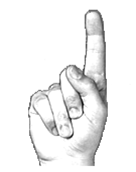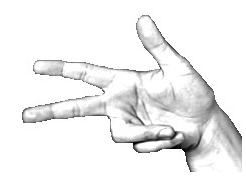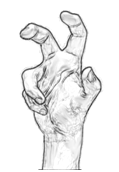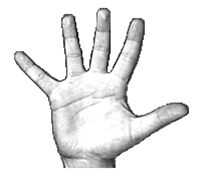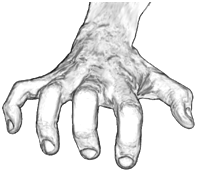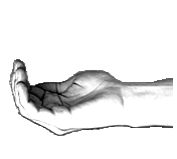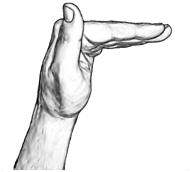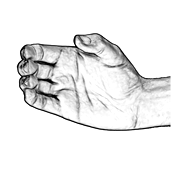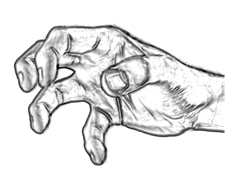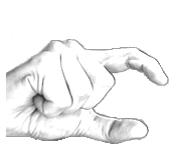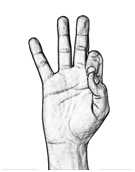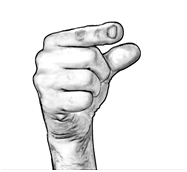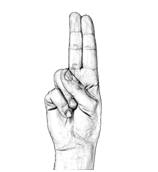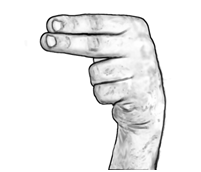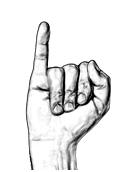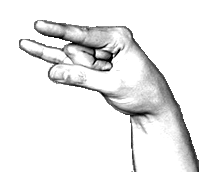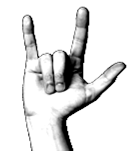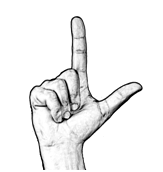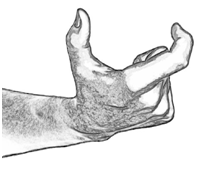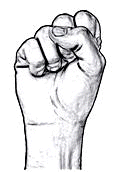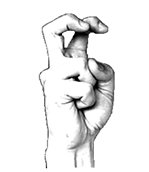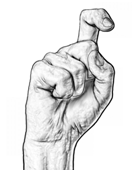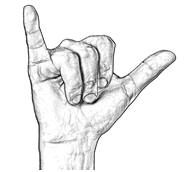"Classifiers Home"
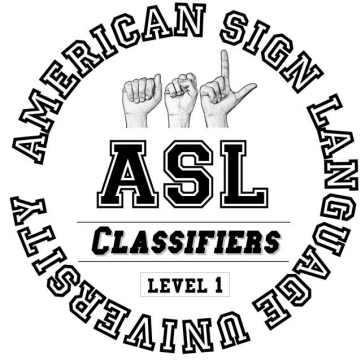
Introduction:
"What is a classifier and how is it different from a handshape?"
Handshapes are one of the five fundamental building blocks or parameters of
a sign: Handshape, movement, location, orientation, and nonmanual markers.
Yes, yes, I know there are those who will point out that some signs have
more than five parameters but notice I used the word "fundamental?" Those
five parameters are the basic categories. The fact that you can
divide "non-manual markers" or other parameters up into several smaller
categories is jolly but there are still five main parameters.
(Nonmanual markers include those aspects of body language that do not
involve the hands such as shoulder movements, head tilts, and facial
expressions.)
The handshape of a sign is literally the shape (or shapes) in which we form
our hand during the production of a sign.
All signs have a handshape.
Now don't go arguing about how "shaking your head" can mean "no" or a body
shift can mean "or."
I'm not talking about non-manual behaviors here -- I'm talking about
signs. Is nodding your head "yes" a sign? No. It is a
non-manual marker.
Classifiers are signs that use handshapes
that are associated with specific categories (classes) of size, shape, or
usage.
Over time certain handshapes have been used so often to show certain types
of things, shapes, amounts, or sizes, that when you hold up or use one of
those handshapes people (who know the language) automatically think of a
particular category (or class) of:
Things (objects, people, animals, vehicles, etc.)
Shapes (including outlines, perimeters, surfaces, configurations,
gradients, etc.)
Sizes (amount, largeness, smallness, relative size, volume, etc.)
Usage (movement paths, speed, interactions, etc.)
The commonly recognized handshapes that are typically used to show different
classes of things, shapes, and sizes are called "classifiers."
The movement and placement of a classifier handshape can be used to convey
information about the movement, type, size, shape, location or extent of the
thing to which you are referring. (A referent is that
which you are talking about or that to which you are referring.)
Classifiers can help to clarify your message, highlight specific details, and provide an efficient way of conveying information.
Classifiers
can be used to:
* describe the size and shape of an
object.
* represent the object itself.
* demonstrate how the object moves.
* convey how it relates to other objects and or people.
Similar to pronouns, that which is being represented (or described) by a classifier must be "introduced" prior to using using the classifier. If I'm going to use a classifier to to talk about Jane, first I'll identify her in some way. (If she is in the room I might point at her. If she is not in the room I might spell her name or point to where she usually sits.) Suppose I want to tell you that my sister "bumped into" her old boyfriend yesterday? I might start by signing "MY SISTER" with raised eyebrows to see if you recall my sister. Then after you nod slightly or otherwise indicate that you know who I'm talking about I might sign, YESTERDAY SHE M-A-L-L CL-1 "walking along, bumped-into" CL-1 FORMER BOYFRIEND.
If I'm talking about throwing a baseball, I'll identify the sport before using a CL-3-claw to represent the ball.
Classifiers tend to mimic the general shape and movement of the objects to which they refer. Suppose I were using a CL-O-flat handshape to represent (the head of) a dinosaur. I would bob the "head" a bit up and down as I moved it forward to represent how the dinosaur was moving. If using that same or a similar handshape (perhaps a slightly curved hand) for a cobra, I would move my arm in such a way as to mimic the cobra's side-to-side dance (or it's strike).
Classifiers often work well with other
classifiers to provide specific details about a situation, event, person, or
thing.
For example, if you want to describe a couch, you can use the sign for COUCH
which is done by signing SIT then using moving both palm-down C-hands
outward. If you wanted to make the point that the couch was lumpy you could
then move your "C" hands in an up and down wavy manner as you move them to
the outside. Or if you wanted to describe the couch as being very long or
being in an L-shape you can move your "C" hands further apart or in an
"L"-movement path.
Classifiers help to paint a more precise
picture of what your object looks like or of what happened. For example,
suppose there was a car crash, what happened to the car? Did the other
driver hit you from the side, the front? What happened to you? Did you hit
your head on the steering wheel or fly through the window?
The list of classifiers below is a work in progress and is therefore not
complete. It is not put forth as a comprehensive list of all the classifiers
that are being used in American Sign Language, or how they are being
used. it is simply a list of some of the more common classifier handshapes.
Note: as you study classifiers on some of these pages I may
mention signs which evolved from classifiers but are so now so common and
standard that they are considered just regular signs, and are no longer
considered classifiers. For example. The sign MEET is a sign, not a
classifier. If however you change the movement speed, path, or orientation
of the "1"-handshapes then the sign is no longer "MEET" but a classifier
that conveys additional information beyond just the basic meaning of "meet."
(For example, perhaps one person tripped and fell right in front of the
other person!)
A few of the more frequently occurring classifiers:
CL-1
CL-3
CL-4
CL-5
CL-A
CL-B- flat things[roof, flat, wall]
CL-C-[thick things, round pole-like things]
CL-C-(modified)(index and thumb) pepperoni,
cookies, campaign buttons
CL-F - small round things: buttons, quarters,
tokens, eyeballs, instrumental classifier for holding on to small things,
(also for showing movement of small flying insects)
CL-G- thin things (or degree of thinness), also "eyelids"
CL-L (bent)-[large, check, card, square.
Related concept: EGO big-headed/egoistic/conceited]
CL-L-[check, card, square]
CL-R
Rope-like, braided, rolled,and/or twisted things.
CL-V- legs, a person walking-(upside-down V), two
people walking, [stand, walk-to, lay down, toss-and-turn, dive, jump, skate
board, scooter, get up]
CL-V (bent fingers) = a small animal, or a larger
animal sitting.
CL-Y Very wide things. A fat person
walking. A hippopotamus's mouth.
|
|
* Long, skinny objects: most commonly, a singular person * Small cylindrical objects: sticks, pencils * Delineating 2 dimensional objects: poster board, plot of land, circle, diamond (any shape) * Trajectory paths and or connections: one way street, two way street, intersection, ball flying midair, a snake moving across a surface, tears
*
The way certain animals move: (modification CL-1>CL-X) caterpillar
crawling, worm tunneling, snail crawling
* Related lexicalized classifiers that have become standardized signs: CATERPILLAR, WORM, MEET, MEET-him/her, BOARD, SIGN-display. [These are not classifiers. They are signs that have evolved from classifiers. They are frozen forms. If you unfreeze them and change their movements they may become classifiers again.] |
|
CL-3
|
* Motorized vehicles: car, tractor, helicopter, bus, motorcycle * Vehicle related events: parking a car, driving erratically, parallel parking, types of car accidents * Vehicle locations: "A car was here." "There was a car in this location facing or moving in this direction." * Groups of 3: 3 people crossing the road * Feet: duck feet, hiking, walking, position of feet as a person walks * Liquid spray over large surfaces: spray painting a car or house
* (upright) sails on a boat
* Related lexicalized classifiers that have become standardized signs: car-ACCIDENT, GARAGE, SHIP-(old_sailing_ship), HIKE, PARKING-LOT, PARKED [These are not classifiers. They are signs that have evolved from classifiers. They are frozen forms. If you unfreeze them and change their movements they may become classifiers again.] |
|
|
* Small objects gripped by the index, thumb and middle finger: computer mouse, baseball, bowling ball * Large beak: commonly used to represent birds of prey, eagle, falcon (if placed in front of mouth) * Hands: (modification of CL-5-claw) particularly for scaling or climbing large object, wall, boulder * Hands that are stashing: stocking shelves, investing in stocks * Containers held by index and thumb, requiring ejection of contents (using thumb): needle, vaccinations |
|
|
* Parallel lines: stripes, bars, fence, upright boundaries * People standing in line. The movement of lines of people. * Objects that flow or leak: bleeding, drool, running water, draining (ear, sink, pipes) * Objects that stream or extend: curtains, hair, streamers, rainbows * Group of 4: 4 people standing or walking together * Traffic: (also "CL-5"), certain types of traffic movement, multi-lane freeways
* bandwidth, streaming (video,
audio)
* Related lexicalized classifiers that have
become standardized signs:
RAINBOW, CURTAINS, IMMIGRATION/admittance, PLAID / Scotland,
BLOOD, "LINE-of-people," SCHEDULE.
[These are not classifiers. They are signs that have evolved
from classifiers. They are frozen forms. If you unfreeze them
and change their movements they may become classifiers again.]
Example of a sentence mixing a
regular sign and a classifier: I went to stand in line and then
noticed that the line was extremely long! |
|
CL-5
|
* Stiff and straight: hairs or fur that stand on end, Mohawk * Objects that are extremely porous: filters, screens * The movement of air, wind, breezes* Group of 5: 5 people standing or walking together * Large flat object: a serving platter, flat lid * Flowing porous objects (using a modified 5) CL-5 > CL-O or CL-O > CL- 5: headlights, flashing lights, sunlight, shower * Objects that have projectile movements: vomit, diarrhea, flash flood, copious tears * Delineate height or movement of water: ocean, flood, rising water, waterfalls, rivers * Traffic: (using a modified 4 or 5 handshape) traffic jam, multi-lane freeways * Upright objects viewed while traveling very fast: commonly used to describe blurred scenery while driving very fast.
* The movement of a fan (blowing air)
* Batting of eyelashes (related to the
sign FLIRT)
* The position or movement of a leaf
* Flame
* Related lexicalized classifiers that have
become standardized signs: LEAF,
TRAFFIC, PORCUPINE
[These are not classifiers. They are signs that have evolved
from classifiers. They are frozen forms. If you unfreeze them
and change their movements they may become classifiers again.] |
| CL-5-(bent) |
* Light
waves or rays, x-rays, microwaves * The movement of an octopus or jellyfish * Transitory handshape involved with spreading outward. * Transitory handshape used in signs involving lights or power turning on or off * Video recording, video conferencing * Webcam usage
* Related lexicalized classifiers that have
become standardized signs: WEBCAM,
MICROWAVE
[These are not classifiers. They are signs that have evolved
from classifiers. They are frozen forms. If you unfreeze them
and change their movements they may become classifiers again.] |
|
|
* Scads of (too many to count): stars in the sky, freckles, audiences or crowds * Large piles (used to show curved top of large piles) * Objects that are rough or jagged: rakes, an animal growling, an animal biting * Objects that are withered or curled up: withered plants * Curly hair, wavy hair * The process of freezing or the state of being frozen * Representing groups of people sitting together: carpools, a group of people packing into a car, people in a raft * clouds, smoke, airborne dust * Balls: holding a ball, throwing a ball * Hands: (modification of CL-5-claw) particularly for scaling or climbing large object, wall, boulder
*
Gnarled: to freeze, wither up, knobby tires
* Related lexicalized classifiers that have
become standardized signs:
SHOCKED-(brain-freeze), FREEZE, RAKE, SCADS, AUDIENCE, RICH,
PLENTY, BITE
[These are not classifiers. They are signs that have evolved
from classifiers. They are frozen forms. If you unfreeze them
and change their movements they may become classifiers again.] |
|
|
* An object in a specified location: a house on a street, a statue or vase on a table, a lamp on a desk. * Positioning in relation to other people or objects: ahead, behind, fall behind, chase, catch up, accompany, spaced apart, above, beneath, facing each other
*
An object or person that commutes: A person going to the
bathroom repeatedly, a person going to work repeatedly, a
ski-lift, a ferry.
* Related lexicalized classifiers that have
become standardized signs:
COMMUTE, DROWN, WITH, “go steady” (couples romance, BACKUP,
CHALLENGE, BASEMENT
[These are not classifiers. They are signs that have evolved
from classifiers. They are frozen forms. If you unfreeze them
and change their movements they may become classifiers again.] |
|
|
* Smooth, flat surfaces: road or runway; wall, hallway, ceiling, floor, shelf * Flat mobile surfaces: surfboard, skateboard, snowboard, people mover (moving sidewalk) * Inanimate objects in specified locations: pictures on a wall, books on a table, racecar on a road * Inanimate objects in specified positions: books lined upright on a shelf, papers facing down * Height and width: a person's height (see CL-B-bent), the width of a box, a stack of books * Delineating 3 dimensional objects: house, box * A non-motorized riding device: horse, bicycle * Combine with CL-1, CL-3, or CL-ILY to show movement over surface
* sea-turtle (using both
hands and wiggling thumbs)
* Related lexicalized classifiers that have
become standardized signs:
horse-RIDE, PAPER
[These are not classifiers. They are signs that have evolved
from classifiers. They are frozen forms. If you unfreeze them
and change their movements they may become classifiers again.] |
|
|
Curved objects: bowl, sink, basin or a digging device
* Related lexicalized classifiers that have
become standardized signs:
a-BOWL, DIG
[These are not classifiers. They are signs that have evolved
from classifiers. They are frozen forms. If you unfreeze them
and change their movements they may become classifiers again.]
|
|
|
* Smooth, flat surfaces: a long stretch of desert or road * Describing a object with sharp corners: the top of an area, such as a shelf or refrigerator * A trailer (such as might be pulled behind a truck)
* Amounts:
less of
* Related lexicalized classifiers that have
become standardized signs:
ROOM/box, SHELF-(variation), EQUAL, LESS, too-MUCH
[These are not classifiers. They are signs that have evolved
from classifiers. They are frozen forms. If you unfreeze them
and change their movements they may become classifiers again.]
|
|
|
* Long cylindrical objects: pipe, cave, tunnel, pole, small tree trunk, large branch * Short cylindrical objects: cup or glass, bottle * Thick objects and/or the thickness or depth of an object: a book, pizza, blanket, stack of papers, biceps, snow fall
* Related lexicalized classifiers that have
become standardized signs:
CUP, BINOCULARS,
[These are not classifiers. They are signs that have evolved
from classifiers. They are frozen forms. If you unfreeze them
and change their movements they may become classifiers again.] |
|
|
* Clusters of objects in specified location: a group of students in the back room, a bouquet of flowers * Sections: location of a room in a house, sections of a city, an article or column in a newspaper * Large objects in a specified location: a house out in the middle of nowhere, a camper on the back of truck * Medium, round, squat objects: cookie, badge, small cap (yarmulke), a large dial, over-ear-headphones * Small spherical objects (with fingers closer together): clown nose, bulging eyes * Large spherical objects (two hands): ball * Teeth: baring teeth, full set of teeth
* Related lexicalized classifiers that have
become standardized signs:
CLOWN, RADIO
[Those are not classifiers. They are signs that have evolved
from classifiers. They are frozen forms. If you unfreeze them
and change their movements they may become classifiers again.]
Example of a sentence mixing a regular sign and a classifier:
The clown had a really big nose. |
|
|
* Small round flat objects: a disc, a piece of food, the moon in the sky * Height and/or width of small objects (similar to CL- G): a small bottle of perfume, a short pencil, a long screw or nail
* Pincers, curved beaks
* Used to
show the holding of small objects between the thumb and index finger
* Related lexicalized classifiers that have
become standardized signs:
PARROT
[These are not classifiers. They are signs that have evolved
from classifiers. They are frozen forms. If you unfreeze them
and change their movements they may become classifiers again.]
|
|
|
* Handling or location of a book * Indication of volume: going flat, on sale, discount * shape of the mouth: smiles or frowns * derogatory portrayment of talking
* Related lexicalized classifiers that have
become standardized signs:
FROWN, SMILE |
|
|
* The use, movement, or placement of small, thin, round objects: button, coin, polka dots, pepperoni, pepper shaker, chain links, rings: ear, nose etc., a single drop of rain, a single snowflake. * Long, thin, cylindrical shaped objects: stick, dowel, curtain rod, small roll of paper, water hose, faucet * Eye gaze: a person looking up or down, eyes moving back and forth, a person rolling his eyes * Person moving along: hiking, walking, wandering around * Small round holes or openings
*
manipulation or holding of very thin things or small things:
flossing, threading a needle, turning a page, pulling out a hair.
* Related lexicalized classifiers that have
become standardized signs:
COINS, BUTTONS
[These are not classifiers. They are signs that have evolved
from classifiers. They are frozen forms. If you unfreeze them
and change their movements they may become classifiers again.]
DYE-(holding on to something and dunking it in dye.) |
|
|
Looks like an "F" handshape but the index and thumb are separated.
* Good for small, round, flat things such as a cookie, or a gold coin (such as a "piece of 8" coin). |
|
|
* Specifies small sizes, shapes, or amounts * The holding and manipulation or state of something relatively small: Ear phones, USB-thumb-drives-(version_1), eye-droppers, uppercase / lowercase (can start "expanded" and change to regular sized to show "lowercase") or can start closed and change to a wide-G or index-thumb-C to show "uppercase") * Short or shallow depths: thin layer of ice, shallow water, a small stack of papers * Flat and thin (or shallow) with squared edges: picture frame, ruler, strip of paper, rails-on-a-railroad * Thin shapes (in general): mustache, sideburns, collar * Small Pinchers: beak of a small bird, tweezers * The movement of eyelids: blinking, waking up, surprise, opening one eye, squinting * Diminishing into the distance / leaving: changes from a wide-G to a closed-G to show concept of "gone" * Come into view suddenly: An object that was far away comes closer (thus appearing larger) by using a closed-G and expanding it into an index-thumb-C. |
|
|
* Thin flat objects: knives, bacon, some types of noodles, name tags or badges, labels, bandage strips * Spreading butter, frosting, or similar substances * Boards: railroad ties, beams-(wood/construction) * A variation of CL- V: legs together, standing on a sidewalk, Joke sign: "Standing Ovation," a person on a surfboard |
|
|
Can include versions of the "H" hand in which the thumb is slightly separated from the fingers and then closes onto them as if showing a clamping or attaching movement.
* Fastening small objects to something else (using a clasping
movement): badges, clip-on earrings, hair barrettes, paper clips |
|
|
Looks like an "H" hand but the thumb is sticking out to the side. |
|
|
* Very thin and long objects: string, yard, wire, thread, cherry stem, thin-stringy noodles * Boundary lines, perimeters * Small or very small paint brushes
|
|
|
* Animals with two horns: bull, ox, cow * Pronged items: goal posts, pitch fork, forklift, and the start of a gun (at the beginning of a race) * Objects with sharp borders for roofs and loose or open sides: tent, canopy, circus, castle, carport * Two long, skinny objects spaced apart from each other: "splits in bowling" |
|
|
* Type of airplane: with slight finger modifications, airplane can become a supersonic jet (CL- RY), a space ship (CL- XY) * Movement: landing, take off, skidding on a runway, crashing in midair |
|
CL-L
|
* Thin squared objects: placemat, driver's license, greeting card * Thin squared objects in a specified location and or position: pictures on a wall, mirror, a window frame * Objects with a short barrel: drill, welding device, gun (pistol), laser |
|
|
* Circular or oval shaped objects: (similar to CL-C-(modified) but larger) dish, rug, platter * Thin round surface: lake, round table, paint spill, round mirror, puddle of water * Spraying device (with index wiggle): window cleaner, water gun |
|
|
* Thick medium sized, cylindrical objects: rod, tree branch, pipe, large cable, firehouse, salt shaker * Viewing devices: goggles, telescope, binoculars |
|
|
* The state of being flat * Having drank a bottle empty, having read a book * Small squat objects (with rounded end): very fast race car * Objects that are round at the bottom and a slight opening at the top: tulips, closed flower bud * Animals with long necks: giraffe, llama, goose, swan, dinosaur, cobra * Thick Claws: (slight modification of CL-O-flat>CL-5) lobster or pinchers * Shutting up (not talking)
Related Lexicalized classifiers: SHUT-UP!, FLAT, LOBSTER, flattened-SELF-ESTEEM
|
|
|
* Braided or twisted material: rope, cable, braids, curled strands (hair or ribbon) * Short, round, somewhat thick with narrowed tips: cigars |
|
|
* Solid, spherical objects: head (of a person or animal); head bobbing, head retreating (into shell) * Ramming device: pistons of a car engine, fist (or anything solid that can be jammed in or packed in tight) Cranking handle: window crank, old fashion ice cream machine * Long thin round hand-held objects: spear, large stirring spoon, rake handle |
|
|
* People (or rather legs of people): laying down, standing up, legs together, kicking * Two long thing things, parallel to one another: train tracks * Two pronged device: fork, forklift * Groups of 2: 2 people walking together or standing * Scissoring object: scissors, claws of a crab or lobster |
|
|
* Seated (person or animal: crouching, squatting, hunched down, perched * Bending knees: climbing stairs or mountains, jumping, sitting, 2-hands-galloping * Arrangement of chairs: chairs in a semi-circle; circle or semi circle; multiple rows * Thin pulling object: bow string, pulling wire (to signal the bus to stop) * Sliding device: sled, roller skates * Raking device: parallel scratch marks or paint streaks * Sets of teeth: chattering teeth * Head of an animal with floppy ears: rabbit * Two pronged teeth: most commonly, snake, vampire, squirrel or chipmunk * Long objects with a connective ending: bones, joints |
|
|
* A person or animal that is crouched or hunched over (using a modified version of CL- 1): a person who skulks, slinks, shrinks or slouches. * A scratching or digging device: scratch or scar, a digging or chipping apparatus (such a pick ax or mining tool) * Anything with a hook: boat anchor, door latch, fishing hook, talons, tow, bat (animal), beaked nose, scorpion's tail, clothes hangers * Long curved sliding device: ice skates, skis * The movement of bent legs: running furiously, cross-legged, kicked-back-(relax), a bull pawing at the ground before charging, (etc.) * The movement of a convertible car's top |
|
|
* A plant ready to sprout * Small bulbous objects: onion, garlic * A snake or frog tongue just before flicking outward from the mouth. * A piece of popcorn prior to popping * The beginning handshape used in spitting or spewing of small amounts of liquid |
|
CL-X-(modified) |
* Small objects commonly held between fingers: key or winding device |
|
CL-X-(closed) |
* The holding and manipulation of something very small, very fine, or very thin such as a needle or a razor blade. |
|
|
* Wide or long objects: hippopotamus' mouth, long word, high heels (stilettos) * Objects with handles: beer mug, pitcher, and in some instances, suitcase, luggage, or briefcase * Long curved object: cow horn, smoking pipe, telephone * Spanning the width or breadth of an object: ruler * Certain types of precision knives: "straight-edge razor" usage |
|
|
____________________________________________
Chatroom discussion:
Dr. Vicars: What is a classifier? What do you think Art?
Art: I think you caught me not doing today's homework.
Dr. Vicars: Heh, sorry, for putting you on the spot.
Heather: It's the form of the fingers or hands to indicate a type of sign. Such as... if you want to sign a cup or a plate, you form either a small circle with the hands, or you form a larger circle with the hands.
Tigie: Like long narrow things and round flat things?
Daniel: Signs that represent classes of objects such as land or water vehicles as a group.
Dr. Vicars: Those are some great answers, I think we are getting there. :) Now give me another example.
Sandy: Like using the index finger to show long skinny things?
Dr. Vicars: Good, right. Let me explain it a bit more for you. If I want to show a person (we will call him "Fred") walking and I have established him on my right I can take my right index finger and move it to the left to represent "Fred" walking across the room (or wherever). The index finger is (in this instance) being used as a classifier. I can also inflect the sign in various ways (speed, distance, movement path, non-manual markers, etc). If I add a non-manual marker such as a facial expression it influences the meaning of my classifier. For example, If I do the CL-1-"walk across the room" sign with a smile It means Fred is happily walking across the room. If I do it quickly It means Fred is hustling etc. [Changing how you do a sign is what you would call "inflecting" the sign for meaning.]
Sandy: What I didn't understand in looking at this was - isn't it overly broad? Is it really understood?
Dr. Vicars: Think of classifiers as a type of pronoun. You have to identify your pronoun before you can use it. Also you have to use it in context. I cant just start a conversation with you by signing, "HE WALK." I have to set up some sort of situation or context, then I spell F-R-E-D, and then point to the right then form the INDEX-finger-classifier (or "Classifier 1" also shown as CL-1) and move it to the left.
Tigie: How do you know that classifier "F" isn't part of a fingerspelled or initialized word instead of representing a small round thing?
Dr. Vicars: Great question. The answer is context. It is the same way you know the letter O and the number 0 (zero) are different. It depends where they show up and how they are used.
Dr. Vicars: I don't expect you all to be experts at classifiers, just want you to know they exist. An example on that "F" concept: If I sign "I BUY NEW SHIRT" then I touch an F on my chest and throw it off suddenly it could mean: "and the button popped off." The "F" classifier acquired the meaning of "button" because of the context (I was talking about "shirts" and placement on my chest).
Tigie: Would everyone understand that a button popped off and not for instance a bottle cap?
Dr. Vicars: Remember this concept: "Show, don't tell." It is much faster
to create an imaginary person or object then show what happens to it or
him--than to describe every item in the situation. In the case of the bottle
cap I would have had to indicate a bottle of some kind before using an f
classifier. The only possible meaning for the classifier in the shirt
example would be a button, because that was the context. People
normally don't wear a row of bottle-caps down the front of their shirts.
Sandy: So, classifiers are used later on in the "sentence," -- it makes more
sense now.
Heather: Why would you use the "F" sign to show a button popped off? Wouldn't you use a "B?"
Dr. Vicars: Because the shape of the fingerspelled letter "F" has a round hole representing the shape of a button. A "B" would be used to represent things that are flat. Remember ASL is not linking to English it is linking to a concept.
Heather: Thanks, that makes perfect sense.
Some of the more popular classifiers:
CL-1 Things that are (relatively) long and skinny. A pencil,
a stick, a person.
CL-A an object in a certain location. A house, a lamp.
CL-3- vehicles,
[motorcycle, park a car, row of cars, accident, garage]
CL-4-[CURTAIN]
CL-5-[scads of]
CL-B- flat things[roof,
flat, wall]
CL-C-[thick things,
round pole-like things]
CL-C-(index and thumb) pepperoni, cookies, campaign buttons
CL-F
CL-G- thin things (or degree of thinness)
CL-L(bent)-[large,
big-headed/egoistic/conceited, check, card, square]
CL-L-[check, card,
square]
CL-V- legs, a person
walking-(upside-down V), two people walking, [stand, walk-to, lay down,
toss-and-turn, dive, jump, skate board, scooter, get up]
CL-V (bent fingers) = a small animal, or a larger animal sitting.
CL-Y Very wide things. A fat person walking (WADDLE).
A hippopotamus's mouth.
Classifiers are signs that are used to represent general categories or "classes" of things. They can be used to describe the size and shape of an object (or person). They can be used to represent the object itself, or the way the object moves or relates to other objects (or people). Another definition is: "A set of handshapes that represent classes of things that share similar characteristics."
Below are some examples of "types" of classifiers. I don't expect you to get
a handle on these just because I list them, but I thought you would enjoy
seeing a sample the diversity of classifiers out there (there are many more
than I'm indicating here). This list is from a study guide I hand out to my
students at the college during certain semesters when I teach from the
Vista, Signing Naturally curriculum (
• Descriptive Classifiers (DCL), are also known as size and shape
specifiers, (SASSes). They describe a person or object.
DCL-B (or bent B) "extremely tall" [Explanation: to represent the
descriptive classifier "extremely tall" you hold the "bent 'B' hand" high in
the air while using an appropriate facial expression."]
DCL-bent-B "short"
DCL-4 "long hair"
DCL-1 "bulletin board"
DCL-1 "black board"
DCL-4 (claw) "freckles"
DCL-4 "striped"
DCL-G "thin"
DCL-4 (claw) "curly hair"
• Semantic Classifiers, represent categories of nouns. For example, people
or vehicles.
SCL-1 (person) "walking fast"
SCL-1 (person) "person walks to...____"
SCL-3 (car) "drives to____"
SCL-Y (fat person) "waddling"
SCL-flattened-O (fast-car) "cruising"
SCL-bent-V (row of chairs)
• Locative Classifiers, show placement or spatial information about an
object. Sometimes indicate movement.
LCL-C/LCL-B "place cup on napkin"
LCL-5 "leaf floating to the ground"
LCL-1 (sticks) "one here-one here"
LCL-B "shelf" (over to the right)
LCL-1 "goal-posts"
(2h)LCL-L "adjust a picture"
• Plural classifiers
Indicating a specific number or a non-specific number.
PCL-2 "two people walking"
PCL-4 "long line of people"
PCL-4 "people moving in line"
PCL- 5 "hordes of _____." Often called "scads of."
PCL-V "people seated in a circle"
• Instrument Classifiers, you use your hands (or an other part of your body)
to manipulate an "object."
ICL "driving"
ICL "hammer in a nail"
ICL "play checkers"
ICL "play chess"
ICL "light match"
ICL (broom) ICL "sweep"
ICL (water) ICL"pour in"
ICL (garbage) ICL "dump out"
ICL (wash-clothes) ICL "hang up"
• Body Classifiers/Mime
You use your body to "act out" or "role play." Sometimes this is like
"mime." Other times you just show the action (or interaction) that is going
on. Often this involves "role shifting."
"yawn"
"acting tough"
"give hug to child"
"running hard/pumping arms"
"wave to crowd"
"listen for strange noise"
• Bodypart classifiers
A specific part of your body is doing an action.
(2h)BPCL-F "look at"
BPCL "kick back" (relax)
BPCL "cross legs"
BPCL ""tap foot"
BPCL (head) "head tilted back"
BPCL-flat-C "big grin"
BPCL-LL "red face" embarrassed / blush
BPCL-BB "mouth frowning"
Student: I don't
get what it means in the outline where it says: SCL-1 (person) "walking
fast"
Dr. Vicars: Oh okay then... let me clarify that.
The SCL simply identifies the general category.
The ":" means what a normal colon means.
The "1" represents making a "one" handshape with you index finger.
The ( ) tells you what it is representing--you have to pre-identify
this in your sentence or conversation.
The manner or how it was done is in the "quotes"
So if I wanted to show "Bob" walking fast, I would fingerspell his name,
then hold up that finger and move it quickly across my signing space. That
would be a classifier indicating how he is moving.
I have a question for you, can you give me a definition for "Classifier Predicates"?
Classifier Predicates:
A classifier (in ASL) is a sign that represents a general category of things, shapes, or sizes.
A predicate is the part of a sentence that modifies (says something about or describes) the topic of the sentence or some other noun or noun phrase in the sentence.
Example: JOHN HANDSOME
The topic is “John” the predicate is an “adjective predicate” describing John’s appearance.
Example: JOHN RUN
The topic is “John” the predicate is a “verb predicate” stating what John did or is doing.
Example: JOHN BED
The topic is “John” the predicate is a “noun predicate” stating John’s location.
Example: JOHN CL-FF “eyes quickly looked at right”
The topic is “John” the predicate is a “classifier predicate” indicating that John quickly looked to his right.
Whenever you use a classifier to describe the shape, size, movement, or location of a noun, you are using a “classifier predicate.”
Bill
Classifier: 1 or index finger CL-1
Classifier: 3 CL-3
Classifier: 5
Classifier: A
Classifier: B and Classifier; BB
Classifier: F
Classifier: H,R, and 4
Classifier: Inverted V and bent inverted V
Classifier: Quantifiers
Classifiers: Size, Location, Movement
Submitted by a reader:
Element classifiers: Describe things that do not have specific shapes or sizes, and are usually in constant motion.
References:
Dr. Bill"s class notes:
3 little pigs story
CL- C>5 "cup spill"
CL- 3 "car weaving on the road"
CL- 5 "leaf drifting to the ground"
CL- X>1"projectile soaring through air"
CL- 55 "wind blowing in one direction"
CL- S "deliver vertical item to"
CL- CLAW>S "catch a small item"
CL- cocked-X>1 "single droplet"
CL- bent-V "person sitting facing me"
CL- O>5: "spill or spread"
CL- C "cup hand to or move to"
CL- S>5-(wiggle) "waterfall"
CL- V/B "jump off edge"
CL- 4/1 "water running out of a faucet"
CL- CLAW-(wiggle) "smoke rising"
CL- S>loose-5 "water spewed out of mouth"
CL- bent-V "people sitting in a semi-circle"
CL- O>5 "water balloon splatting onto side of head"
The thing to realize is that if you are Deaf, and/or if you use ASL
regularly with native Adult signers -- at some point you will start
coming up with YOUR
OWN opinions regarding various classifiers and your opinion will help
inform and further develop the topic. And you might actually come up
with new "classifications of classifiers." Or you might come up with
"sub-categories" of classifiers. For example, my wife, Belinda
Vicars, came up with the phrase:
"Trajectory Classifiers" (such as "projectiles") which show the movement
path, distance, and speed of objects. Such classifiers are perhaps best
considered a
subset of "locatives." Is "Trajectory Classifiers" an
original term? I "think so" but then again there are thousands of people
out there thinking about, developing, and writing about the structure
and usage of signs. That only bolsters my point: If you are
active in the Deaf community and/or if you use ASL regularly with native
Adult signers I encourage you to note your observations, think about
them, and share those observations in an organized manner with others.
- Dr. Bill
Note to Classifiers Students:
I'm building these links and pages as time goes on. If you need to see
something specific, let me know. - Dr. Bill
ARTICLE-(An article or column in a newspaper)
(This sign is not a classifier, but if you modify the sign it can be used as
a classifier to depict various meanings.)
biceps
BINOCULARS (lexicalized classifier)
bo staff
bottle
BRAIN-"big-brained" / "double_brained" /
very knowledgeable /
2nd Brain
branch-(off of a tree)
camper (a camper on the back of truck)
cave
CLUSTER (group, plural or as a whole,
MAN-cluster = "men"
WOMAN-cluster = women
TEACHER-cluster = teachers)
cup or glass (lexicalized classifier)
located-at:
a house in the middle of nowhere
Long vehicles: limousine
pipeline
pizza: deep-dish
pole or very small tree trunk
THICK (thick objects and/or
the thickness or depth of an object) [1] [2]
thick blanket
thick-BOOK: a thick book (See
THICK and scroll down)
tunnel
snow layer
stack of papers
trolley movement
THERE-(location or
placement of a room, house, structure, or large object") (large
objects in a specified location), sections and locations:
sections of a city
CL:C-claw
Medium, round, squat objects:
COOKIE (The sign "COOKIE" is not a classifier, but
if you modify the sign it can be used as a classifier to depict various
meanings.)
badge
small cap (yarmulke)
a large dial
over-ear-headphones or muffs
You asked: "...and then claw C over the ears. Ear muffs or headphones?"
Answer: It could be either depending on the context. Classifiers function to
some extent as "pronouns" and must typically first be identified.
For example "MY SON BOUGHT NEW I-P-A-D. NOW HE WANT CL-C: "headphones." (Or,
more likely CL-G: "earbuds").
Small spherical objects:
bulbous (clown) nose
bulging eyes
bump on head
Large spherical objects
(two hands) ball
Teeth: baring teeth
full set of teeth
lexicalized classifier examples
Now just regular signs:
CLOWN
RADIO
Example of a sentence
mixing a regular sign
and a classifier:
The clown had a really big nose.
CL:C-(index_&_thumb)
Small round flat objects:
a disc
a piece of food
taking a bite of a cookie
the moon in the sky
Height and/or width of small objects
a small bottle of perfume
a short pencil
a long screw or nail
Pincers, curved beaks
Example of a sentence
mixing a regular sign
and a classifier:
My friend was walking past my parrot …
and my parrot bit him on the shoulder!
Long cylindrical objects: Short cylindrical objects:
EYES-wide
SUN-(specific_location)
